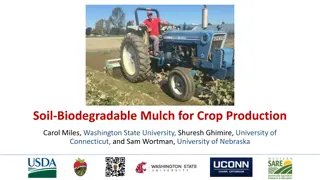Understanding GMOs: The Science and Impact
Bioengineered crops, or GMOs, are developed through genetic engineering to enhance specific traits. Despite thorough evaluation by regulatory bodies, GMOs have become prevalent in the market, especially in livestock feed production. While organic products offer a non-GMO guarantee, the adoption of bioengineered seeds can be beneficial in countries lacking resources. However, the widespread use of bioengineered seeds has also led to increased food prices due to their production costs.
Download Presentation

Please find below an Image/Link to download the presentation.
The content on the website is provided AS IS for your information and personal use only. It may not be sold, licensed, or shared on other websites without obtaining consent from the author. Download presentation by click this link. If you encounter any issues during the download, it is possible that the publisher has removed the file from their server.
E N D
Presentation Transcript
Bioengineered crops (GMOs) are created by injecting chemicals into food AFTER it is harvested GMOs are developed through genetic engineering where scientists identify and insert specific traits into the DNA of the seed before it is ever planted. The plant grows just like conventional (non-GMO) seeds. The transgenic trait is then transferred to other varieties through traditional cross-breeding. See The Life of a Seed-Jake, a GMO Seed
After a bioengineered crop variety is developed, it is thoroughly evaluated by the USDA, FDA, and EPA to identify unintended consequences to the environment or to our health if consumed. It takes many years for a GMO to be approved first for field testing and second for commercial production.
GMOs have bombarded the produce section of the grocery store. It is difficult to avoid fruits and vegetables that have been bioengineered. There are only 10 approved varieties of GMO plants. Of those crops, 5 could be found in the produce section. They are sweet corn, papaya, potatoes, squash, and the arctic apple (The arctic apple won t be available on store shelves for a few more years)
The bulk of bioengineered crops that are harvested in the US are for the use of livestock feed. GM field Corn, Alfalfa, Soybeans, and the by-products of sugar beets and cotton harvested in the United States are all used to feed livestock.
If I purchase food labeled with the USDA Organic seal, I know these products did not grow from a bioengineered seed In addition to other growth and production requirements, foods with the Organic seal were not grown from GM seeds.
Using bioengineered crop varieties in every country would be beneficial. Many third world countries do not have the technology and resources to utilize the benefits of GM crops. For example, if a farmer in another country does not have access to herbicides, using herbicide tolerant crops would not be beneficial.
The implementation of bioengineered seeds over the last 20 years has increased the price of food. A study shows that the prices of corn, soybeans and canola would probably be 5-9% higher than if GM technology was not available to farmers. The Production and Price Impact of Biotech Crops
Health studies about the safety of consuming bioengineered crops are less than 30 years old GM crops have only been in production since 1996. While studies have shown they are safe, their scope is limited to the amount of time they have been in production and use.
GMOs are NOT directly linked to being a cause for cancer. Bioengineered crop varieties pose no greater risk of increasing the risk of cancer than their conventional counterparts. A decade of EU-funded GMO Research Compilation of Research on GM Crops
Studies show that bioengineered crops are linked to an increase in allergies. 90% of all allergies are caused by peanuts, tree nuts, milk, eggs, wheat, soy, shellfish, and fish. To date, only soy even has a GM variety. See more explanation: Are GMOs causing an increase in allergies?
Bioengineered crops are contributing to the death of butterflies. Butterflies would need to eat the Bt found in GM crops to have it kill them. Butterflies are not pests, and therefore do not feed on the actual plants. Dominic Reisig, North Carolina State University
There arent any known environmental risks to producing and growing bioengineered crops. Environmental risks are known, which leads to monitoring and testing before approval of a new GM crop. Scientists monitor GM crops to watch for unintended consequences that could be seen long term such as herbicide tolerance, biodiversity concerns, and affect on non-target organisms.























